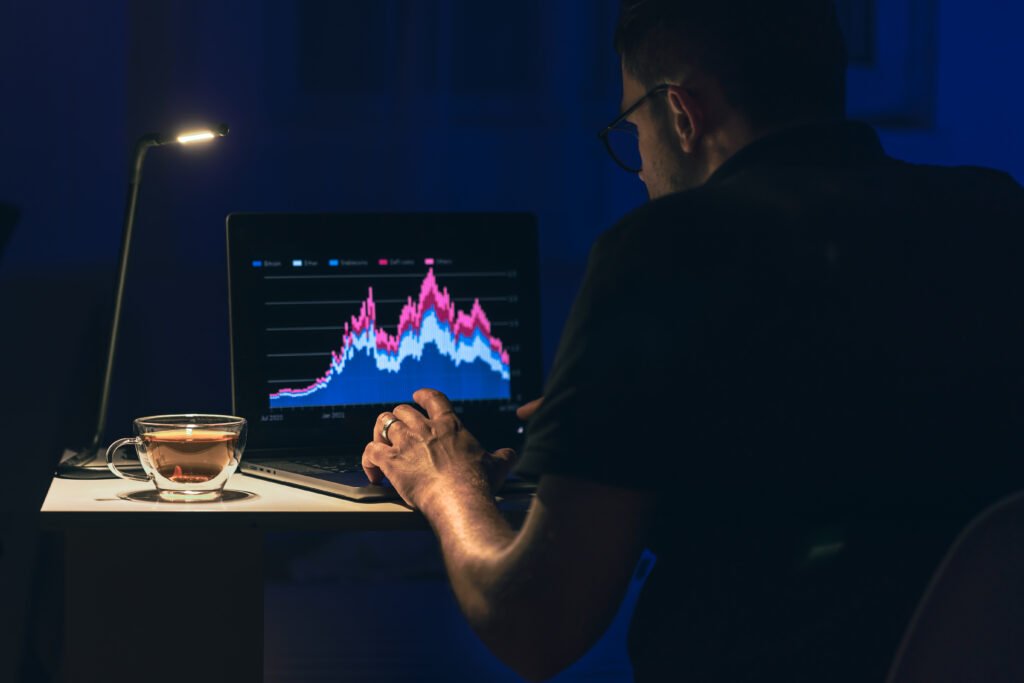5 Proven Ways to Interpret Crypto Signals Like a Pro
1. Why Interpreting Crypto Signals Matters
Don’t Just Follow — Understand the Logic
Crypto signals are everywhere — Telegram, Discord, Twitter, Reddit — and many promise quick gains. But blindly following them is a fast track to losing money. Most beginner traders act on signals without fully understanding the technical or strategic reasoning behind them. This can lead to poorly timed entries, emotional exits, and missed opportunities.

Table of Contents
How Pros Turn Signals Into Smart Trades
Professional traders don’t just take signals at face value — they decode them. They look beyond the entry price and target, digging into the technical indicators, risk/reward balance, and market conditions that justify the trade. By interpreting the signal properly, they can adjust position size, tweak stop-loss levels, and make more confident decisions. That’s what separates consistent traders from copy-paste gamblers.
2. Understand the Structure of a Crypto Signal
Before acting on any crypto signal, it’s essential to understand its structure. Every legitimate and professional signal follows a predictable format — and knowing how to read it correctly is the first step toward trading it successfully.
Common Elements in a Signal: Entry, TP, SL, Risk
A standard crypto signal typically includes:
- Entry Price – The price at which you’re recommended to enter the trade.
- Take Profit (TP) – One or more target prices where you can secure profits.
- Stop Loss (SL) – A defined exit point to limit your loss if the trade moves against you.
- Risk Level or Confidence – Some signals include a risk/reward label or rating (e.g., Low/Medium/High Risk).
Understanding these elements helps you evaluate whether the trade fits your risk profile and strategy — and whether it’s even worth taking.
Decoding Timeframes and Pair Notations
Signals often specify timeframes (e.g., 1H, 4H, Daily), which indicate the chart setup and expected duration of the trade. Misreading this can lead to entering a short-term scalp with a long-term mindset — a common and costly mistake.
You’ll also see trading pairs formatted like:
- BTC/USDT (Bitcoin against Tether)
- ETH/BTC (Ethereum against Bitcoin)
Knowing what base and quote assets are involved is critical, especially when trading altcoins in volatile markets.
Spot vs Futures: Know the Difference
One of the biggest errors new traders make is not distinguishing between spot and futures signals.
- Spot Signals: Intended for regular buying/selling of crypto without leverage.
- Futures Signals: Involve leveraged trading and can include both long (buy) and short (sell) positions.
Trading a futures signal on a spot exchange — or vice versa — could result in missed profits or unintended losses. Always confirm the context before acting.
3. Analyze the Technical Indicators Behind the Signal
A high-quality crypto signal is rarely based on guesswork — it’s often rooted in technical analysis. To interpret it like a pro, you need to understand the indicators that likely shaped it. This insight allows you to validate or adjust the signal to suit your own strategy and risk profile.
RSI, MACD, EMA: What the Signal Is Really Telling You
Most technical signals rely on key indicators:
- RSI (Relative Strength Index): Measures momentum and identifies overbought (>70) or oversold (<30) conditions. A buy signal might come when RSI bounces from oversold territory, signaling a potential trend reversal.
- MACD (Moving Average Convergence Divergence): Helps spot trend direction and momentum shifts. A bullish signal often aligns with a MACD crossover above the signal line.
- EMA (Exponential Moving Average): Smooths price data to identify trends. Signals that suggest a bounce off the 50 EMA or a golden cross (50 EMA crossing above 200 EMA) are common in trend-following strategies.
If a signal doesn’t make sense in the context of these tools, be cautious — it might lack a strong technical foundation.
Support & Resistance: Are You Entering at the Right Zone?
Pros never enter blindly. They ask:
- Is this signal calling for entry near a support level?
- Is the TP realistic, or is it set right below a major resistance zone?
Signals that encourage buying into resistance or selling into support are often traps. You want confirmation that the trade is aligned with broader market structure — not just isolated indicators.
Use tools like horizontal lines, Fibonacci retracement, or order block zones to validate whether the entry and exit points are reasonable.
Volume Confirmation – The Missing Piece Most Ignore
Even if all other indicators line up, volume tells you whether there’s real strength behind a move.
A signal recommending a breakout buy, for instance, is far more trustworthy when paired with rising volume — indicating strong interest and momentum.
On the flip side, a breakout without volume is a red flag for a possible fakeout.
Volume also helps confirm divergence, consolidation breakouts, and trend strength. Pro traders rarely trade without looking at it — neither should you.
4. Assess the Risk-Reward Ratio Before You Act
Even a technically sound signal can be a poor trade if the risk-to-reward ratio (R:R) doesn’t make sense. Professional traders don’t just chase potential profits — they evaluate the quality of the opportunity. A good R:R setup ensures that your wins outweigh your losses over time, even if your win rate is average.
Calculate Your R:R to Filter Out Bad Signals
The Risk-Reward Ratio compares how much you’re risking to how much you stand to gain. A standard guideline used by pros is at least 1:2 or 1:3, meaning for every $1 risked, you’re aiming to gain $2 or $3.
Example:
- Entry: $100
- Stop-Loss: $95 (risk = $5)
- Take Profit: $115 (reward = $15)
- R:R = 1:3
If a signal offers a 1:1 or worse, it’s often not worth taking — especially in volatile crypto markets where price can hit SL (stop-loss) frequently.
Use Position Sizing to Match Your Risk Appetite
Professional traders never “go all in” on any trade — they manage exposure based on their total portfolio.
- Determine how much capital you’re willing to lose per trade (e.g., 1–2% of total portfolio).
- Use position sizing calculators to determine how many coins or contracts to buy based on your SL level.
This protects your capital during losing streaks and avoids emotional decisions caused by oversized trades.
Avoid Overexposure in High-Volatility Trades
Not all crypto assets carry the same level of risk. Micro-cap coins or small liquidity altcoins can swing wildly — meaning your SL could get hit easily even if the signal is valid longer term.
For such trades:
- Use smaller positions.
- Consider wider stop-loss zones.
- Lower your leverage (if using futures).
Being aggressive in volatile conditions without risk control is a recipe for liquidation — or worse, complete capital loss.
5. Consider the Broader Market Context
Even the most technically perfect crypto signal can fail if the overall market conditions aren’t in its favor. Pro traders always zoom out before zooming in. They assess whether the signal aligns with the larger market sentiment, Bitcoin’s price action, and macro events.
News Events, BTC Movement, and Market Sentiment
A signal to go long on an altcoin may look great — but if Bitcoin is tanking, that trade could sink with it.
Watch for:
- Major economic announcements (CPI, Fed rates, regulations)
- Global crypto news (ETF approvals, exchange hacks, whale moves)
- Market sentiment (fear/greed index, social trends)
Before acting on any signal, ask:
“Is this trade swimming with or against the market current?”
Correlation Between Altcoins and Bitcoin
Most altcoins are heavily correlated to Bitcoin — especially in bearish phases. If Bitcoin is consolidating, some altcoins may rally. But if BTC is in a sharp downtrend, altcoins typically drop even faster.
Pro tip:
- Use BTC.D (Bitcoin Dominance) and TOTAL2 (altcoin market cap) charts on TradingView to understand the flow of capital between BTC and alts.
- Don’t blindly follow a signal that contradicts BTC’s momentum unless it’s a short-term scalp.
Be Wary of Signals in Choppy or Ranging Markets
Some of the worst-performing signals are those placed during sideways, uncertain, or low-volume markets. These conditions increase the chance of:
- Fake breakouts
- Stop-loss hunting
- Low momentum trades
In ranging markets:
- Focus on mean reversion signals (buy low in the range, sell high).
- Use tighter targets and SLs.
- Be patient — the best signals come when trend clarity returns.
6. Track, Test, and Improve Your Signal Strategy
Getting better at interpreting crypto signals isn’t just about technical skills — it’s about continuous learning and refinement. Pro traders don’t just act; they analyze what worked, what didn’t, and why. By tracking and testing your trades, you move from guesswork to a data-driven edge.
Use Journals or Tools to Log Trades and Learn
Every trade you make is a learning opportunity — especially those based on external signals. Use a trade journal to log:
- The original signal (entry, SL, TP)
- Date/time of trade
- Why you took the trade
- Outcome (win/loss, R:R, exit reason)
- What you learned
You can use tools like:
- Excel/Google Sheets
- TradingView’s notes feature
- Journaling platforms like Edgewonk, TraderSync, or CoinMarketMan
Over time, you’ll spot patterns in profitable vs poor signals — and adjust accordingly.
Backtesting: How to Validate Signal Performance
Before trusting a signal strategy or provider, backtest it using historical data. You can do this manually or use platforms that allow backtesting (like TradingView with Pine Script or custom spreadsheets).
Ask:
- How often do signals hit TP vs SL?
- What’s the average risk-reward?
- What’s the win rate over 50–100 trades?
Backtesting turns a “gut feeling” into measurable data — and helps you avoid wasting time on low-quality signals.
When to Trust a Signal Provider (and When to Ditch Them)
Not all signal providers are created equal. Here’s how to vet them:
✅ Transparent track record with verified results
✅ Clear entry/exit strategy with SL and TP
✅ Risk disclaimers and education included
✅ Responsive to market changes and BTC sentiment
🚫 Avoid providers who:
- Never show losses
- Use vague language (e.g., “Might moon soon!”)
- Rely heavily on hype or emotional marketing
- Don’t explain their reasoning behind trades
If a signal provider consistently gives poor results — even with perfect technicals — ditch them. Your capital deserves better.
7. Conclusion: Turn Crypto Signals Into an Edge
Crypto signals can be powerful tools — but only if you know how to interpret them wisely. Following signals blindly is like trading in the dark. It might work occasionally, but it won’t last. The real edge lies in understanding the logic behind the signal and aligning it with your own strategy, risk tolerance, and market outlook.
From Blind Following to Smart Interpreting
The difference between beginners and pros isn’t access to better signals — it’s how they read and respond to them.
Pro traders:
- Analyze the technical indicators behind a signal
- Check the risk-reward ratio
- Validate it against broader market context
- Size their positions responsibly
- Keep track of outcomes and adjust
When you approach signals this way, you stop gambling and start trading with purpose.
Master the Process, Not Just the Entry Point
The entry price is just one piece of the puzzle. Real success comes from mastering the entire process — from signal interpretation to trade execution, journaling, and reflection.
So next time you get a signal, ask yourself:
“Do I understand why this trade makes sense — and does it fit my plan?”
8. FAQs
Q1: What’s the Best Way to Learn Signal Analysis?
Start by learning the basics of technical analysis — RSI, MACD, moving averages, support/resistance, and candlestick patterns.
Pair that with practical experience:
- Follow signal groups and compare their calls with live charts
- Use demo accounts or paper trading to test your interpretations
- Log your trades and analyze what worked and why
Resources like TradingView, YouTube tutorials, and TA-focused blogs are great places to begin. Over time, you’ll develop your own criteria to judge any signal.
Q2: Are Telegram Signals Reliable?
Some are — many are not. Telegram is full of signal groups, but very few are transparent or backed by a solid track record.
To spot reliable ones, look for:
- Verified performance history
- Clear entry/exit/SL targets
- Risk disclaimers and market context
- Consistent education and updates
Avoid channels that offer only hype, unrealistic returns, or no loss tracking. Always do your own due diligence — DYOR (Do Your Own Research) is key.
Q3: Can You Automate Signal Execution Safely?
Yes, automation tools and signal bots can execute trades based on signals — especially with platforms like 3Commas, TradeSanta, or Copy Trading platforms like Bybit, Binance, or eToro.
But automation is only as good as the signals you feed into it.
✅ Use tested strategies
✅ Set proper stop-loss and take-profit levels
✅ Monitor regularly — bots can’t adapt to sudden news or crashes
Automation is best when paired with a solid manual understanding and a reliable, proven signal source.
Read Also: 5 Most Trusted Crypto Communities You Shouldn’t Miss







